Years of service 1913–1946 Name Stanislaw Sosabowski | Rank Major General | |
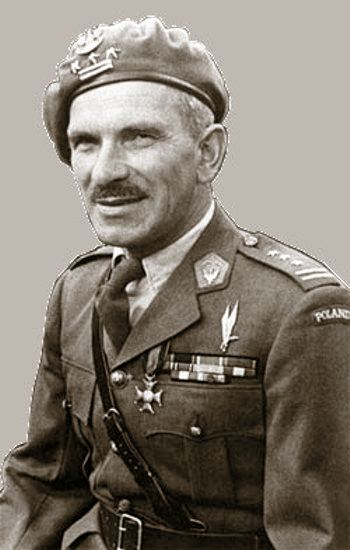 | ||
Allegiance Austro–Hungarian Empire Poland Service/branch Austro-Hungarian ArmyPolish Land Forces | ||
Stanisław Franciszek Sosabowski CBE ([staˈɲiswaf sɔsaˈbɔfskʲi]; 8 May 1892 – 25 September 1967) was a Polish general in World War II. He fought in the Battle of Arnhem (Netherlands) in 1944 as commander of the Polish 1st Independent Parachute Brigade.
Contents
- Early years and studies
- World War I
- Interwar period
- Invasion of Poland 1939
- France
- Great Britain
- Warsaw Uprising
- Battle of Arnhem
- After the war
- Awards
- References
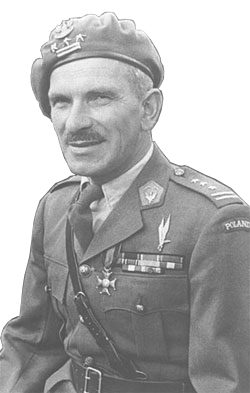
Early years and studies
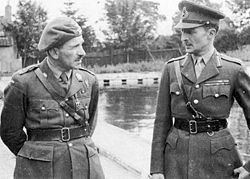
Stanisław Sosabowski was born on 8 May 1892, in Stanisławów, in a railway workers' family. He graduated from a local gymnasium and in 1910 he was accepted as a student of the faculty of economy of the Jagiellonian University in Kraków. However, the death of his father and the poor financial situation of his family forced him to abandon the studies and return to Stanisławów. There he became a member of Drużyny Strzeleckie, a semi-clandestine Polish national paramilitary organisation. He was soon promoted to the head of all Polish Scouting groups in the area.
World War I
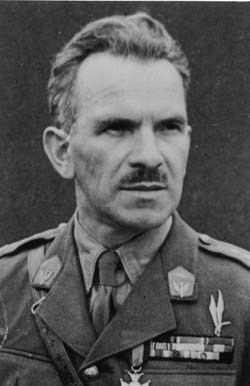
In 1913, Sosabowski was drafted into the Austro-Hungarian Army. After training, he was promoted to the rank of corporal, serving in the 58th Infantry Regiment. After the outbreak of World War I he fought with his unit against the Imperial Russian Army in the battles of Rzeszów, Dukla Pass and Gorlice. For his bravery, he was awarded several medals and promoted to First Lieutenant. In 1915, he was badly wounded in action and withdrawn from the front.
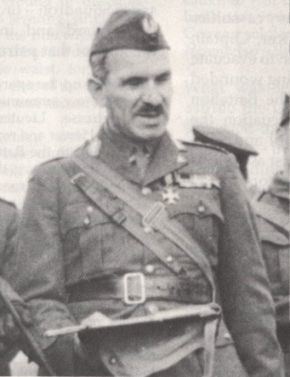
In November 1918, after Poland regained its independence Sosabowski volunteered for the newly formed Polish Army, but his wounds were still not healed and he was rejected as a front-line officer. Instead, he became a staff officer in the Ministry of War Affairs in Warsaw.
Interwar period
After the Polish-Soviet War Sosabowski was promoted to Major and in 1922 he started his studies at the Higher Military School in Warsaw. After he finished his studies he was assigned to the Polish General Staff. Promoted to Lieutenant Colonel, in 1928 he was finally assigned to a front-line unit, the 75th Infantry Regiment, as commanding officer of a battalion. The following year he was assigned to the 3rd Podhale Rifles Regiment as its deputy commander. From 1930 he was also a professor of logistics at his alma mater.
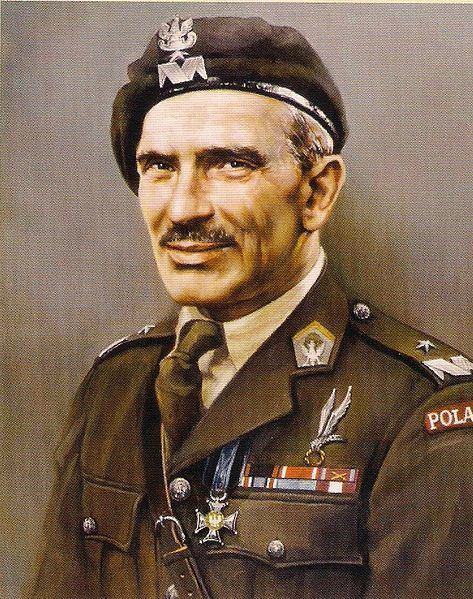
In 1937 Sosabowski was promoted to colonel and became the commanding officer of the 9th Polish Legions Infantry Regiment stationed in Zamość. In January 1939 he became the commander of the prestigious Warsaw-based 21st "Children of Warsaw" Infantry Regiment.
Invasion of Poland 1939
According to the Polish mobilisation scheme, Sosabowski's regiment was attached to the 8th Infantry Division under Col. Teodor Furgalski. Shortly before the German invasion of Poland started his unit was moved from its garrison in the Warsaw Citadel to the area of Ciechanów, where it was planned as a strategic reserve of the Modlin Army.
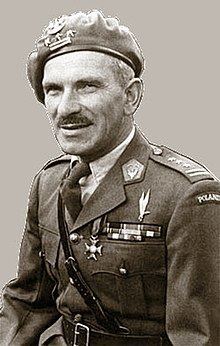
On 2 September the division was moved towards Mława and in the early morning of the following day it entered combat in the Battle of Mława. Although the 21st Regiment managed to capture Przasnysz and its secondary objectives, the rest of the division was surrounded by the Wehrmacht and destroyed. After that Sosabowski ordered his troops to retreat towards Warsaw.
On 8 September Sosabowski's unit reached the Modlin Fortress. The routed 8th Division was being reconstructed, but the 21st Regiment was attached to the corps led by general Juliusz Zulauf. After several days of defensive fights, the corps was moved to Warsaw, where it arrived on 15 September.
Instantly upon arrival, Sosabowski was ordered to man the Grochów and the Kamionek defensive area and defend Praga, the eastern borough of Warsaw, against the German 10th Infantry Division. During the Siege of Warsaw the forces of Sosabowski were outmanned and outgunned, but managed to hold all their objectives. When the general assault on Praga started on 16 September, the 21st Infantry Regiment managed to repel the attacks of German 23rd Infantry Regiment and then successfully counter-attacked and destroyed the enemy unit.
After this success, Sosabowski was assigned to command all Polish troops fighting in the area of Grochów. Despite constant bombardment and German attacks repeated every day, Sosabowski managed to hold his objectives at relatively low cost in manpower. On 26 September 1939, the forces led by Sosabowski bloodily repelled the last German attack, but two days later Warsaw capitulated. On 29 September, shortly before the Polish forces left Warsaw for German captivity, General Juliusz Rómmel awarded Col. Sosabowski and the whole 21st Infantry Regiment with the Virtuti Militari medal.
France
Following the Polish surrender, Sosabowski was made a prisoner of war and interned at a camp near Żyrardów. However, he escaped and remained in Warsaw under a false name, where he joined the Polish resistance. He was ordered to leave Poland and reach France to report on the situation in occupied Poland. After a long trip through Hungary and Romania, he arrived in Paris, where the Polish government in exile assigned him to the Polish 4th Infantry Division as the commanding officer of infantry.
Initially, the French authorities were very reluctant to hand over the badly needed equipment and armament for the Polish unit. Sosabowski's soldiers had to train with pre-World War I weapons. In April 1940, the division was moved to a training camp in Parthenay and was finally handed the weapons awaited since January, but it was already too late to organise the division. Out of more than 11,000 soldiers, only 3,150 were given arms. Knowing this, the commander of the division General Rudolf Dreszer ordered his unit to withdraw towards the Atlantic coast. On 19 June 1940, Sosabowski with approximately 6,000 Polish soldiers arrived at La Pallice, whence they were evacuated to Great Britain.
Great Britain
Upon his arrival in London, Sosabowski turned up at the Polish General Staff and was assigned to 4th Rifles Brigade that was to become a core of the future 4th Infantry Division. The unit was to be composed mainly of Polish Canadians, but it soon became apparent that there were not enough young Poles in Canada from which to create a division.
Then, Sosabowski decided to transform his brigade into a Parachute Brigade, the first such unit in the Polish Army. The volunteers came from all the formations of the Polish Army. In Largo House in Fife, a training camp was built and the parachute training was started. Sosabowski himself passed the training and, at 49 years of age, made his first parachute jump. According to relations of Sosabowski's former subordinates, the colonel was a strict yet just commander. Impulsive and harsh, Sosabowski could not stand any opposition. This made the creation of a Polish parachute brigade possible, but also made contacts with his superiors problematic.
In October 1942 the Brigade was ready for combat and was named the 1st Independent Parachute Brigade. Since the Polish General Staff planned to use the Brigade to assist a national uprising in Poland, the soldiers of the 1st Polish Para were to be the first element of the Polish Army in Exile to reach their homeland. Hence the unofficial motto of the unit: the shortest way (najkrótszą drogą).
In September 1943, Lieutenant-General Frederick Browning proposed that Sosabowski reform his unit into a division and fill the remaining posts with Englishmen. Sosabowski himself would be assigned to the newly formed division and promoted to general. However, Sosabowski refused. Nevertheless, on 15 June 1944 he was promoted to Brigadier General.
Warsaw Uprising
In early August 1944, news of the Warsaw Uprising arrived in Great Britain. The Brigade was ready to be dropped by parachute into Warsaw to aid their colleagues from the underground Polish Home Army, who were fighting a desperate battle against overwhelming odds. However, the distance was too great for the transport aircraft to make a round trip and access to Soviet airfields was denied. The morale of the Polish troops suffered badly and many of the units verged on mutiny. The British staff threatened its Polish counterpart with disarmament of the Brigade, but Sosabowski retained control of his unit. Finally, Polish Commander in Chief Kazimierz Sosnkowski put the Brigade under British command, and the plan to send it to Warsaw was abandoned. It was not until after the war that General Sosabowski learnt that his son, Stanisław "Stasinek" Sosabowski, a medic and member of the Kedyw, had lost his sight during the uprising.
Battle of Arnhem
The Polish 1st Independent Parachute Brigade was among the Allied forces taking part in Operation Market Garden. Due to a shortage of transport aircraft, the brigade was split into several parts before being dropped into the battle. A small part of the brigade with Sosabowski was parachuted near Driel on 19 September, but the rest of the brigade arrived only on 21 September at the distant town of Grave, falling directly on the waiting guns of the Germans camped in the area. The brigade's artillery was dropped with the British 1st Airborne Division, commanded by Major-General Roy Urquhart, while the howitzers were to arrive by sea, which prevented the brigade from being deployed effectively. Three times Sosabowski attempted to cross the Rhine to come the assistance of the surrounded 1st Airborne Division. Unfortunately, the ferry they hoped to use had been sunk and the Poles attempted the river crossing in small rubber boats under heavy fire. Even so, at least 200 men made it across the river and reinforced the embattled British paratroopers.
Despite the difficult situation, at a staff meeting on 24 September, Sosabowski suggested that the battle could still be won. He proposed that the combined forces of XXX Corps, under Lieutenant-General Brian Horrocks, and the 1st Polish Parachute Brigade should start an all-out assault on the German positions and try to break through the Rhine. This plan was not accepted, and during the last phase of the battle, on 25 and 26 September, Sosabowski led his men southwards, shielding the retreat of the remnants of the 1st Airborne Division. Casualties among the Polish units were high, approaching 40%, and were at least in part, the result of Lieutenant-General Browning's decision to drop the paratroops just 7 kilometres from the bridge at Arnhem.
After the battle, on 5 October 1944, Sosabowski received a letter from Field Marshal Bernard Montgomery, commander of the Anglo-Canadian 21st Army Group, describing the Polish soldiers as having fought bravely and offering awards to ten of his soldiers. However, on 14 October 1944, Montgomery wrote another letter, this time to the British commanders, in which he scapegoated Sosabowski for the failure of Market Garden. Sosabowski was accused of criticising Montgomery, and the Polish General Staff was forced to remove him as the commanding officer of his brigade on 27 December 1944.
At the Moscow Conference (9–19 October 1944), a turning point came in the Anglo-Polish relationship. On Prime Minister Churchill’s request, the Polish delegation arrived in Moscow on 12 October 1944. Upon arrival, Churchill told them to be present at the discussions between himself, Joseph Stalin and the Communist Polish Lublin Committee. Consequently, Churchill coerced Polish Prime Minister Stanisław Mikołajczyk to cooperate with Stalin’s disciples or lose Britain’s support for the remainder of the war. From the British perspective, any news that could be beneficial to their coercion tactics would be welcome. The information came on 16 October in a telegram to Field Marshal Sir Alan Brooke, the Chief of the Imperial General Staff (CIGS), who was present in Moscow as Churchill’s military advisor.[1]
The message stated that Sosabowski’s brigade performed badly. Churchill could use this ‘piece of evidence’ to put more pressure on Mikołajczyk to cooperate, because his valuable asset, Sosabowski’s elite troops, were no longer useful to the allied war effort. Montgomery’s telegram is exceptional to his behaviour in that timeframe. Two days prior to the telegram he was praising the Polish contribution to the war and not even six weeks later he was honouring Maczek and his Poles by giving them a Distinguished Service Order. In addition, war correspondents spoke highly of the Polish contribution to Operation Market Garden in the same period as Montgomery was expressing his negative experiences, via Field Marshal Brooke, to Prime Minister Churchill.[2]
Sosabowski was eventually made the commander of rearguard troops and was demobilised in July 1948. He was portrayed by Gene Hackman in the 1977 war film A Bridge Too Far.
After the war
Shortly after the war Sosabowski succeeded in bringing his wife and only son from Poland. Like many other Polish wartime officers and soldiers who were unable to return to Communist Poland he settled in West London. He found a job as a factory worker at the CAV Electrics assembly plant in Acton. He died in London on 25 September 1967. It has been suggested that until his funeral at which his rank and achievements were read out, many of his friends and workmates in England were largely unaware of his military accomplishments. In 1969, Sosabowski's remains were returned to Poland, where he was reinterred at Powązki Military Cemetery in Warsaw.
In The Hague, on 31 May 2006, Queen Beatrix of the Netherlands awarded the Military Order of William to the 1st Independent Polish Parachute Brigade. Despite British diplomatic pressure, the brigade's commander, Sosabowski, was posthumously awarded the "Bronze Lion". In part this was the result of a Dutch TV documentary depicting the brigade as having played a far more significant role in Market Garden than had been hitherto acknowledged. In this film by Geertjan Lassche, Prince Bernhard of the Netherlands said the Poles deserved to be honoured with at least a medal.
The following day, on 1 June, a ceremony was held at Driel, the town where the Polish 1st Independent Parachute Brigade fought. Among the speakers at the ceremony were the mayor of Overbetuwe, as well as Sosabowski's grandson and great-grandson.
In the summer of 2012 1st Airborne Major Tony Hibbert made a video appeal for Sosabowski to be pardoned and honoured.
His bust was unveiled on 1 September 2013 in Kraków's Jordan Park. This is one of many Polish historical figures honoured in the Park.
Awards
He was awarded many military honours, including:
